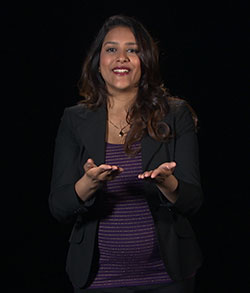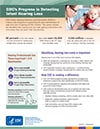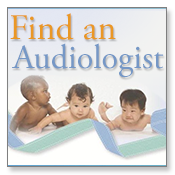CDC’s Work on Hearing Loss
CDC is committed to hearing loss surveillance, research, and health education. Our goal is to help children reach their full potential.

Role of CDC in Early Hearing Detection and Intervention (in ASL)
In American Sign Language, a CDC epidemiologist briefly describes CDC’s role in early hearing detection and intervention. (No audio, but with captioning – captions may be turned on and video quality adjusted from the YouTube player settings menu).
Watch the video

CDC’s EHDI has made clear progress in supporting the early identification in deaf and hard of hearing infants. The earlier children with hearing loss are identified and start getting intervention, the more likely they will reach their full potential. This factsheet demonstrates what CDC EHDI is doing and has done to support jurisdictions in identifying hearing loss early.
Tracking Hearing Loss in Children
CDC has been tracking the number of children with hearing loss since the early 1980’s. By studying the number of people with hearing loss over time, we can find out if the number is rising, dropping, or staying the same. We can also compare the number of children with hearing loss in different groups of people. This information helps us look for potential risk factors for hearing loss and helps health departments, service providers and early intervention programs to estimate case loads, plan for services, and advocate for needed resources.
Promoting & Tracking Early Screening, Diagnosis, and Intervention
When a child’s hearing loss is identified soon after birth, families and professionals can make sure the child gets timely follow-up testing and intervention services at an early age. This will help the child develop communication and language skills that will last a lifetime.
CDC’s Early Hearing Detection and Intervention (EHDI) Program works with states and territories to ensure that infants are screened for hearing loss no later than one month of age, infants who do not pass the screening for hearing loss get a full hearing evaluation no later than 3 months of age, and infants with a hearing loss receive intervention services no later than 6 months of age.
Preventing Hearing Loss
CDC works to understand more about the risk factors that can increase the chance that a child will have hearing loss. This information is helpful in educating people about ways to help prevent hearing loss in children.
For example, we have learned that babies exposed to cytomegalovirus infection (CMV) before birth have an increased risk for hearing loss. Therefore, we strive to educate pregnant women, professionals, and the public about ways to prevent CMV infection and have a healthy pregnancy.
Understanding More about Hearing Loss

CDC funds many different studies to learn more about how common hearing loss is and the types of hearing loss, the experience of children with hearing loss and their families, and ways of improving services to those families.
Learn More
To learn more about the projects described above, visit our Research & Tracking page
Learn about the work taking place in the states and territories receiving EHDI funding
Early Hearing Detection and Intervention (EHDI) Program National Goals
Questions?
If you have questions about hearing loss, please e-mail us at: Contact CDC-INFO
